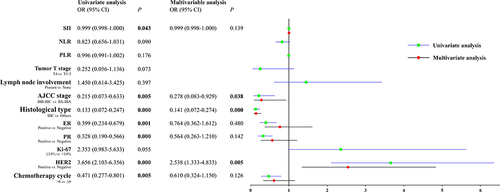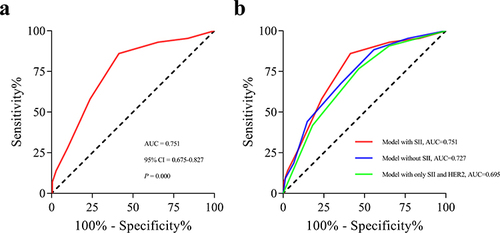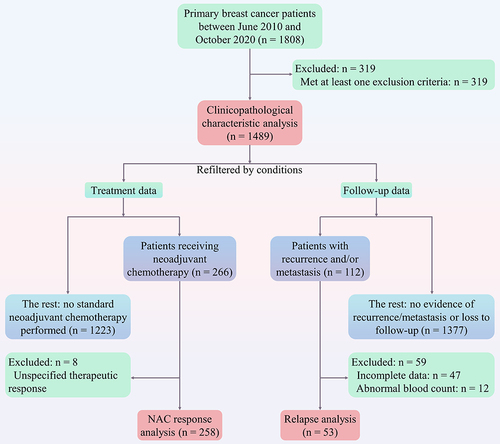Figures & data
Figure 1 Conceptual framework of the study. Immuno-inflammatory cells play pivotal roles in tumorigenesis and progression. α-granules released by platelets in the TME promote tumor angiogenesis and boost metastasis of breast cancer cells. Through an intimate cellular interaction with platelets and endothelial cells, neutrophils are tethered to the vascular endothelial cells and migrate from the vascular compartment to the tissue. Subsequently, activated neutrophils produce a large amount of ROS, which together with ARG1 suppress the antitumor function of lymphocytes and NK cells. Peripheral blood inflammation indices reflect the level of local immune inflammation in the TME. These parameters collected before, during, and after initial treatment may aid in precision medicine in patients with breast cancer.

Table 1 Clinicopathological Characteristics of All 1489 Patients with Breast Cancer
Table 2 The Correlation Between Pretherapeutic NLR/PLR/SII and Clinicopathological Characteristics Among All 1489 Patients with Breast Cancer
Table 3 Clinicopathological Characteristics of 258 Patients Undergoing Neoadjuvant Chemotherapy
Table 4 Univariate and Multivariable Analysis for Risk Factors of Poor Chemotherapy Response
Figure 3 Univariate and multivariate analyses of pathological complete response by forest plots. P: p-value, bold p-value indicated a statistical difference. Other bold text represents methods or variables for regression analysis.

Table 5 The Predictive Scoring System for Breast Cancer Chemotherapy Efficacy
Figure 4 The newly established predictive scoring model efficiently predicts poor chemotherapeutic response in breast cancer patients. (a) Receiver operating characteristic (ROC) and area under the curve (AUC) analyses pertaining to pretherapeutic systemic immune-inflammation index (SII)-based predictive scoring model. (b) Comparison between the SII-based predictive scoring model and other models. Figure 4 was generated by GraphPad Prism version 8.

Table 6 The Accuracy of the Predictive Scoring Model Tested by an Independent Cohort
Table 7 Dynamic Changes of NLR/PLR/SII Before, During, and After Initial Treatment

